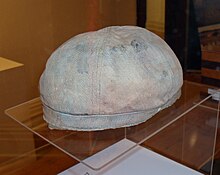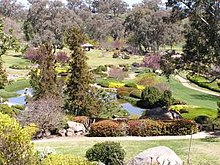Cowra breakout: Difference between revisions
Rescuing 1 sources and tagging 0 as dead. #IABot (v1.1) |
|||
| Line 79: | Line 79: | ||
*[http://www.teachingheritage.nsw.edu.au/b_expressing/wb2_mckenzie.html Wal McKenzie, "Memories of the Cowra Breakout"] (no date) |
*[http://www.teachingheritage.nsw.edu.au/b_expressing/wb2_mckenzie.html Wal McKenzie, "Memories of the Cowra Breakout"] (no date) |
||
*[http://www.hindu.com/thehindu/mag/2005/02/13/stories/2005021300250700.htm "Uprisings remembered" ] S. Muthiah, in ''[[The Hindu]]'' (Indian national newspaper). (13 February 2005) |
*[http://www.hindu.com/thehindu/mag/2005/02/13/stories/2005021300250700.htm "Uprisings remembered" ] S. Muthiah, in ''[[The Hindu]]'' (Indian national newspaper). (13 February 2005) |
||
*[http://www.naa.gov.au/Publications/fact_sheets/fs198.html "Fact Sheet 198: Cowra outbreak, 1944"] [[National Archives of Australia]]. (2000) |
*[https://web.archive.org/web/20050901171134/http://www.naa.gov.au/Publications/fact_sheets/fs198.html "Fact Sheet 198: Cowra outbreak, 1944"] [[National Archives of Australia]]. (2000) |
||
* [http://www.japantimes.co.jp/life/2013/03/17/general/ghosts-of-cowra-breakout-haunt-japan-to-this-day/ ''Japan Times'', "Ghosts of Cowra breakout haunt Japan to this day"] |
* [http://www.japantimes.co.jp/life/2013/03/17/general/ghosts-of-cowra-breakout-haunt-japan-to-this-day/ ''Japan Times'', "Ghosts of Cowra breakout haunt Japan to this day"] |
||
{{Prison riots and uprisings}} |
{{Prison riots and uprisings}} |
||
Revision as of 20:07, 20 July 2016
 Cowra POW Camp, 1 July 1944. Japanese POWs practising baseball near their quarters, several weeks before the Cowra breakout. Australia took the photograph as the Allies intended to use it in propaganda leaflets, to be dropped on Japanese-held areas in the Asia-Pacific region. | |
| Date | 5 August 1944 |
|---|---|
| Location | Near Cowra, New South Wales, Australia |
| Outcome | ~545 Japanese POWs escape |
| Deaths | 235 |
The Cowra breakout occurred on 5 August 1944, when at least 1,104 Japanese prisoners of war attempted to escape from a prisoner of war camp near Cowra, in New South Wales, Australia. It was the largest prison escape of World War II, as well as one of the bloodiest. During the ensuing manhunt, 4 Australian soldiers and 231 Japanese soldiers were killed. The remaining escapees were captured and imprisoned.
POW camp
Cowra, a farming district, 314 km due west of Sydney, was the town nearest to No. 12 Prisoner of War Compound, a major POW camp, where 4,000 Axis military personnel and civilians were detained. The prisoners at Cowra also included 2,000 Italians, Koreans who had served in the Japanese military, and Indonesian civilians detained at the request of the Dutch East Indies government.[1]
By August 1944, there were 2,223 Japanese POWs in Australia, including 544 merchant seamen. There were 14,720 Italian prisoners, who had been captured mostly in the North African Campaign, and 1,585 Germans, mostly naval or merchant seamen.
Although the POWs were treated in accordance with the 1929 Geneva Convention, relations between the Japanese POWs and the guards were poor, due largely to significant cultural differences.[citation needed] A riot by Japanese POWs at Featherston prisoner of war camp in New Zealand, in February 1943, led to security being tightened at Cowra. Eventually the camp authorities installed several Vickers and Lewis machine guns to augment the rifles carried by the members of the Australian Militia's 22nd Garrison Battalion, which was composed mostly of old or disabled veterans or young men considered physically unfit for frontline service.
Breakout


In the first week of August 1944, a tip-off from an informer at Cowra led authorities to plan a move of all Japanese POWs at Cowra, except officers and NCOs, to another camp at Hay, New South Wales, some 400 km to the west. The Japanese were notified of the move on 4 August.
In the words of historian Gavin Long, the following night:
- At about 2 a.m. a Japanese ran to the camp gates and shouted what seemed to be a warning to the sentries. Then a Japanese bugle sounded. A sentry fired a warning shot. More sentries fired as three mobs of prisoners, shouting "Banzai", began breaking through the wire, one mob on the northern side, one on the western and one on the southern. They flung themselves across the wire with the help of blankets. They were armed with knives, baseball bats, clubs studded with nails and hooks, wire stilettos and garotting cords.[2]
The bugler, Hajime Toyoshima, had been Australia’s first Japanese prisoner of the war.[3] Soon afterwards, prisoners set most of the buildings in the Japanese compound on fire.
Within minutes of the start of the breakout attempt, Privates Ben Hardy and Ralph Jones manned the No. 2 Vickers machine-gun and began firing into the first wave of escapees. They were soon overwhelmed by the sheer weight of numbers and killed. Before dying, Private Jones managed to remove and hide the gun's bolt, rendering the gun useless. This prevented the prisoners from turning the machine gun against the guards.
Prime Minister John Curtin later described the actions of the Japanese POWs in storming machine gun posts, armed only with improvised weapons, as a "suicidal disregard of life". Some 359 POWs escaped. Some prisoners, rather than escaping, attempted or committed suicide, or were killed by their countrymen. Some of those who did escape committed suicide to avoid recapture. All survivors were recaptured within 10 days of their breakout.[4]
During the escape and subsequent round-up of POWs, four Australian soldiers and 231 Japanese soldiers were killed and 108 prisoners were wounded. The leaders of the breakout ordered the escapees not to attack Australian civilians, and none were killed or injured.
The government conducted an official inquiry into the events. Its conclusions were read to the Australian House of Representatives by Curtin on 8 September 1944. Among the findings were:
- Conditions at the camp were in accordance with the Geneva Conventions;
- No complaints regarding treatment had been made by or on behalf of the Japanese before the incident, which appeared to have been the result of a premeditated and concerted plan;
- The actions of the Australian garrison in resisting the attack averted a greater loss of life, and firing ceased as soon as they regained control;
- Many of the dead had committed suicide or been killed by other prisoners, and many of the Japanese wounded had suffered self-inflicted wounds.[citation needed]
Privates Hardy and Jones were posthumously awarded the George Cross as a result of their actions.
Australia continued to operate No. 12 Camp until the last Japanese and Italian prisoners were repatriated in 1947.
Cowra maintains a significant Japanese war cemetery. In addition, a commemorative Japanese garden was later built on Bellevue Hill to memorialize these events. The garden was designed by Ken Nakajima in the style of the Edo period.[5]
Depictions in film and literature
- Dead Men Rising, (1975), Angus & Robertson, ISBN 0-207-12654-2): a novel by Seaforth Mackenzie, who was stationed at Cowra during the breakout.[6]
- Die like the Carp: The Story of the Greatest Prison Escape Ever, (1978), Corgi Books, ISBN 0-7269-3243-4) by Harry Gordon.[7]
- The Cowra Breakout (1984): a critically acclaimed 4½-hour television miniseries, written by Margaret Kelly and Chris Noonan, and directed by Noonan and Phillip Noyce.[8][9]
- On That Day, Our Lives Are Lighter Than The Toilet Paper: The Great Cowra Breakout (English translation) あの日、僕らの命はトイレットペーパーよりも軽かった -カウラ捕虜収容所からの大脱走 (2008): a 2-hour TV-movie produced by Nippon Television as a 55th-anniversary special. [10]
See also
References
This article includes a list of general references, but it lacks sufficient corresponding inline citations. (April 2009) |
- ^ http://www.cowraregion.com.au/home/?id=2295
- ^ Gavin Long, "The prison breakout at Cowra, August 1944", in Australia in the War of 1939-1945, (Published by) the Australian War Memorial. (1963)
- ^ S Thompson. Exhibit - Objects through Time: COWRA bugle, c1930s, Migration Heritage Centre, New South Wales, 2006
- ^ Wendy Lewis, Simon Balderstone and John Bowan (2006). Events That Shaped Australia. New Holland. pp. 175–179. ISBN 978-1-74110-492-9.
- ^ Tam, Tracy, "Australian town commemorates 1944 POW camp breakout", The Japan Times, (Kyodo News), 19 August 2014
- ^ "Dead men rising / [by] Kenneth Seaforth Mackenzie". National Library of Australia. Retrieved 11 August 2010.
- ^ "Die like the carp : the story of the greatest prison escape ever / Harry Gordon". National Library of Australia. Retrieved 11 August 2010.
- ^ "The Cowra Breakout - Curator's notes + clips & credits". National Film and Sound Archive (NFSA). Retrieved 24 November 2011.
- ^ "The Cowra Breakout (TV mini-series 1984)". IMDb. Retrieved 24 November 2011.
- ^ "Ano Hi Bokura no Inochi wa Toiretto Pepa yori mo Karukatta".
External links
- "The Cowra Breakout" David Hobson in World War II 1939-45 (Published by) the ANZAC Day Commemoration Committee (Qld) Incorporated. (1998)
- "Official Cowra Japanese Garden Home Page"
- Gavin Long, "The prison breakout at Cowra, August 1944", in Australia in the War of 1939-1945, (Published by) the Australian War Memorial. (1963)
- Wal McKenzie, "Memories of the Cowra Breakout" (no date)
- "Uprisings remembered" S. Muthiah, in The Hindu (Indian national newspaper). (13 February 2005)
- "Fact Sheet 198: Cowra outbreak, 1944" National Archives of Australia. (2000)
- Japan Times, "Ghosts of Cowra breakout haunt Japan to this day"
- Use dmy dates from February 2011
- 1944 riots
- 1944 in Australia
- History of New South Wales
- World War II prisoner-of-war camps in Australia
- Prison uprisings
- Military history of Australia during World War II
- Military camps in Australia
- POW escapes and rescues during World War II
- Military history of Japan during World War II
- 20th century in New South Wales
